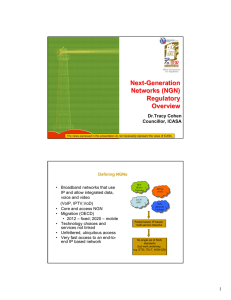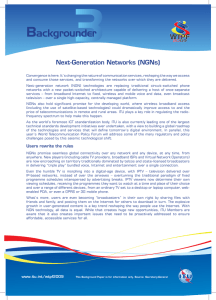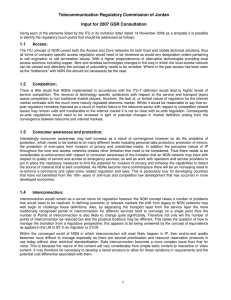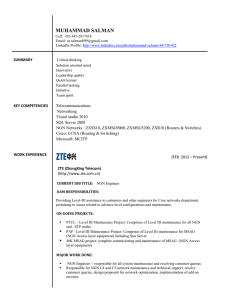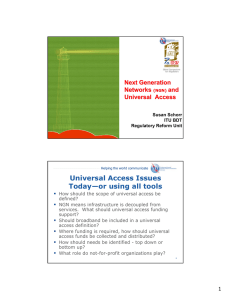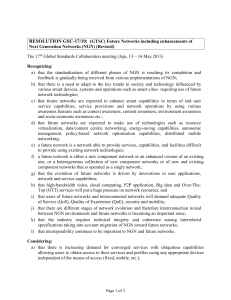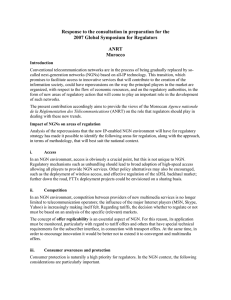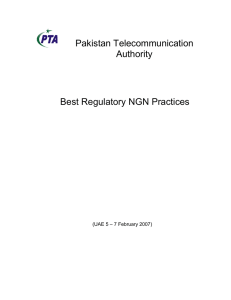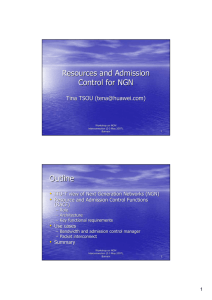Regulatory Frameworks for NGN Migration
advertisement
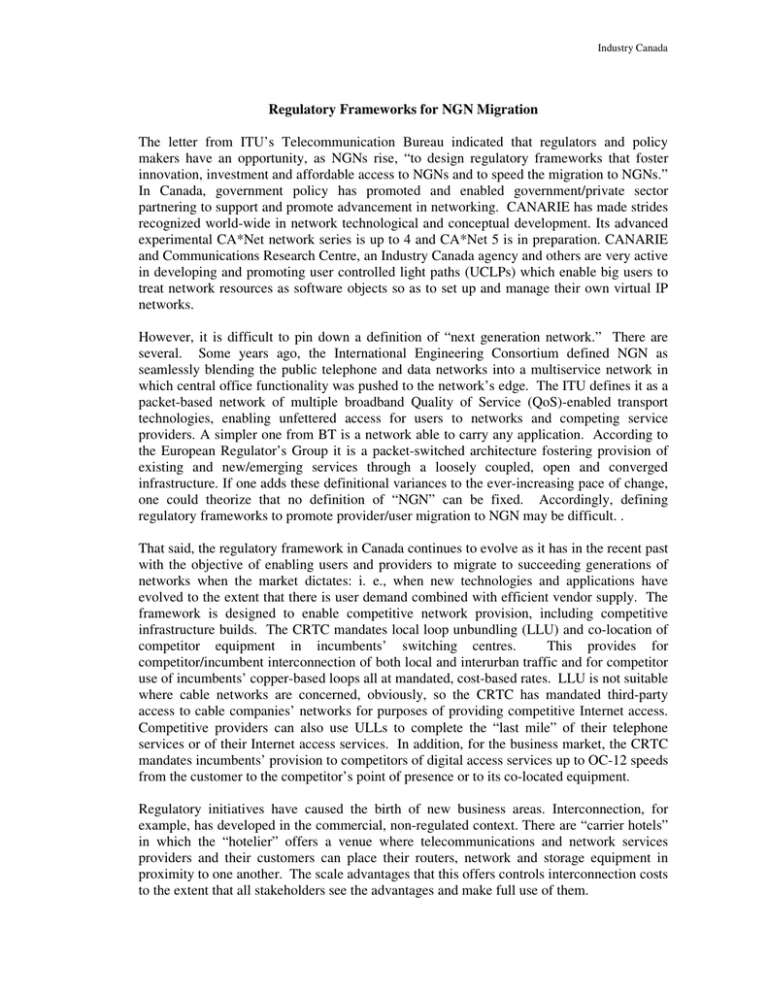
Industry Canada Regulatory Frameworks for NGN Migration The letter from ITU’s Telecommunication Bureau indicated that regulators and policy makers have an opportunity, as NGNs rise, “to design regulatory frameworks that foster innovation, investment and affordable access to NGNs and to speed the migration to NGNs.” In Canada, government policy has promoted and enabled government/private sector partnering to support and promote advancement in networking. CANARIE has made strides recognized world-wide in network technological and conceptual development. Its advanced experimental CA*Net network series is up to 4 and CA*Net 5 is in preparation. CANARIE and Communications Research Centre, an Industry Canada agency and others are very active in developing and promoting user controlled light paths (UCLPs) which enable big users to treat network resources as software objects so as to set up and manage their own virtual IP networks. However, it is difficult to pin down a definition of “next generation network.” There are several. Some years ago, the International Engineering Consortium defined NGN as seamlessly blending the public telephone and data networks into a multiservice network in which central office functionality was pushed to the network’s edge. The ITU defines it as a packet-based network of multiple broadband Quality of Service (QoS)-enabled transport technologies, enabling unfettered access for users to networks and competing service providers. A simpler one from BT is a network able to carry any application. According to the European Regulator’s Group it is a packet-switched architecture fostering provision of existing and new/emerging services through a loosely coupled, open and converged infrastructure. If one adds these definitional variances to the ever-increasing pace of change, one could theorize that no definition of “NGN” can be fixed. Accordingly, defining regulatory frameworks to promote provider/user migration to NGN may be difficult. . That said, the regulatory framework in Canada continues to evolve as it has in the recent past with the objective of enabling users and providers to migrate to succeeding generations of networks when the market dictates: i. e., when new technologies and applications have evolved to the extent that there is user demand combined with efficient vendor supply. The framework is designed to enable competitive network provision, including competitive infrastructure builds. The CRTC mandates local loop unbundling (LLU) and co-location of competitor equipment in incumbents’ switching centres. This provides for competitor/incumbent interconnection of both local and interurban traffic and for competitor use of incumbents’ copper-based loops all at mandated, cost-based rates. LLU is not suitable where cable networks are concerned, obviously, so the CRTC has mandated third-party access to cable companies’ networks for purposes of providing competitive Internet access. Competitive providers can also use ULLs to complete the “last mile” of their telephone services or of their Internet access services. In addition, for the business market, the CRTC mandates incumbents’ provision to competitors of digital access services up to OC-12 speeds from the customer to the competitor’s point of presence or to its co-located equipment. Regulatory initiatives have caused the birth of new business areas. Interconnection, for example, has developed in the commercial, non-regulated context. There are “carrier hotels” in which the “hotelier” offers a venue where telecommunications and network services providers and their customers can place their routers, network and storage equipment in proximity to one another. The scale advantages that this offers controls interconnection costs to the extent that all stakeholders see the advantages and make full use of them. Industry Canada As for universal service, the Canadian framework provides for telecom operators’ contribution to the fund based on telecom revenues. The fund supports a subsidy that is portable: that is, a local exchange carrier that undertakes to provide telephone service in designated high-cost areas can collect from the fund as prescribed. At present, it is applicable to telephone service only. Approaches such as these will not necessarily be adequate or suitable in an NGN environment. However, the approaches described above exemplify the regulatory flexibility needed to support technical and service evolution and to ensure no undue distortion of the discipline and allocative efficiency of the market, all to the benefit of users. Approaches such as these can be expected to deliver similar results as consumer demand and provider supply move the market toward NGN. Concerns arise, perhaps, less within the traditional categories of regulatory frameworks and more in issues that are arising in the Internet context and will likely apply to NGNs. Providers have traditionally provided services on their own networks. Accordingly, telecom competition entailed competition in infrastructure to the greatest degree possible while still sustaining competition, and this still tends to be the approach. The NGN model, however, could be one in which there need not be multiple builds of network infrastructure to achieve full allocative efficiency. A single network could be sufficient to allow all manner of competition at the “service” layer. In this event, regulators will have to find ways of ensuring that the NGN network provider/operator is prevented from restricting service level competition to its own undue advantage. NGN quality of service issues will have to be addressed. Traffic prioritization and shaping for QoS purposes will be essential. However, as in the current “Net neutrality” debate, there will be questions of whether regulators should or should not allow operators to engage in traffic shaping for commercial gain; and if not, where to set limits and how to enforce them. In sum, current approaches, as long as they ultimately keep the customer/user in mind, will be sufficient for purposes of migration to NGNs. The issue really is, once the NGN takes shape, how regulation can and should be applied to continue to serve the interests of customers/users.
